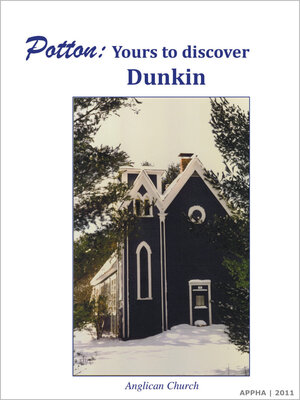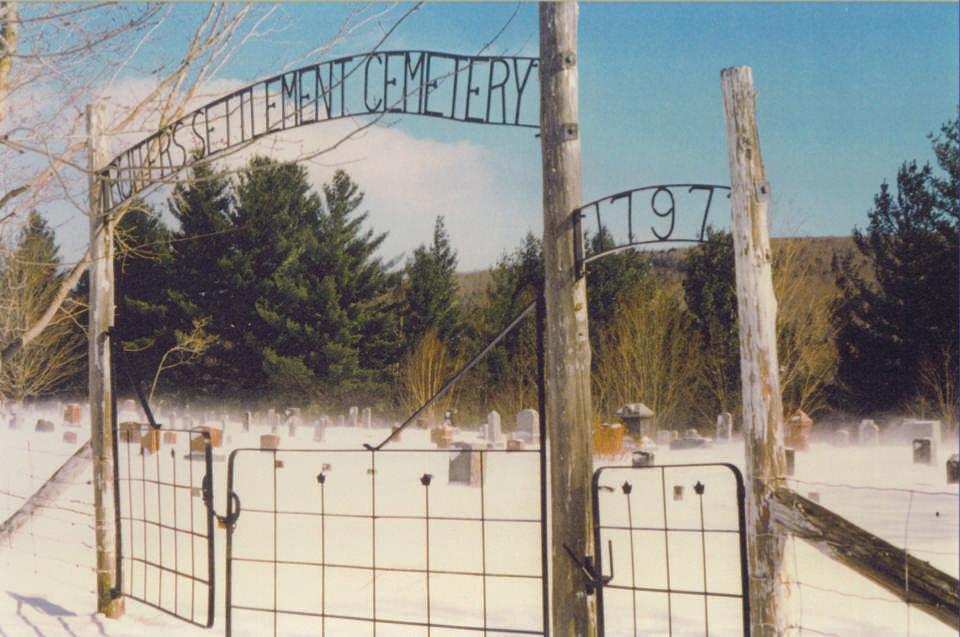Dunkin
Situated about half a mile from the Missisquoi River, near the mouth of Ruiter Brook, Dunkin is gateway to the Ruiter Valley penetrating into the Sutton Mountains. As one of Potton’s oldest settlements, Dunkin evokes the feeling of a small rural village of the early 1900’s.
Many of its historical buildings have disappeared, and some of those remaining are in poor condition, a consequence of a vanished local economy. Nonetheless, Dunkin is a place of considerable charm and heritage in our Township.
Its beginnings
Dunkin was first simply called West Potton, and was founded by Loyalist Hendrick Ruiter in 1796. Colonel Ruiter was born in 1739 near Albany, New York, a second-generation colonist. He led a company of Roger’s Rangers, a militia group aiding the British army during the American Revolution. In 1796, he was granted 2,400 acres of land for his loyalty and brought his family to Potton. He built the first saw and grist mills in Potton around 1800, thus beginning the rapid development of the territory. Hendrick Ruiter died in 1819, at the age of 79 years.
One family’s courage and determination to carve a new life here began it all. The Hendrick Ruiter Memorial marker, placed in 1906, commemorates the location of his first log cabin. Colonel Ruiter, his wife and several of their descendants are buried nearby, in the magnificent Ruiter Settlement Cemetery, the first in Potton.
In 1895, West Potton was renamed to Dunkin by its citizens, for the Honourable Christopher Dunkin, a parliamentarian who sponsored the Canada Temperance bill of 1864, also known as the Dunkin Act. He is said to have delivered so stirring a speech in West Potton that it gave rise to a popular movement for the name change! Christopher Dunkin was a lawyer, teacher, editor, soldier, politician and judge. He was instrumental in bringing the South Eastern Railway to the Missisquoi Valley, an invaluable asset for the transportation of lumber and increasing the commerce of the area. Christopher Dunkin died in 1881 at his home in Knowlton.
The settlement
Originally a primitive frontier road led through West Potton, and over time, Dunkin became a stopover point for the stagecoach route between Troy and St. John’s (St. Jean sur Richelieu). Livery stables, blacksmith shops, and inns were a necessity. Saw mills, cheese factories, general stores, a school, two churches and a post office soon followed. Agriculture thrived on fertile land enriched by the annual flooding of the Missisquoi River, while vast forests nearby supplied an ever-increasing need for lumber.
Around 1850, Mark L. Elkins, a descendant of another early settler, built an inn here, called the Wayside Inn, or the Stage Coach Inn, which has been home to the Sherrer family since 1941. From 1945 to 1975, another type of accommodation grew in Dunkin, when Herman and Marguerite Omerli operated a Canadian Youth Hostel in their home.
Dunkin’s first church, the Union Church, remains standing on chemin Ruiter Brook. It was built by Elder B.S. Reynolds, an Advent minister, in 1879. It was closed in 1972 and sold to private interests.
An Anglican Church, built in 1881 by Archdeacon Ker, was transformed into a schoolhouse in 1923. It was used until 1951 as a school, and later became the home of filmmaker Pierre Falardeau.
General stores once operated by Herb Truax, Wilbur Fullerton, Archie O’Brien and Leon Aiken are long gone, casualties of a lost farming economy.
When telephone service came in 1918, it was on poles installed by the residents themselves. Electricity came to Dunkin only in 1948.
Agriculture and industry
Small dairy farms thrived on the fertile land, leading to production of cheese and butter. From 1950 to 1960, Tony Oberlin, a Swiss immigrant, made the cheeses of his homeland from locally produced milk : Tilsit, and Limburger, an odorous, creamy and flavourful cheese, not for the faint of heart! Early in the 1900’s, commercial logging companies such as the Missisquoi Lumber Company moved into the region, followed by the Singer Sewing Machine Company around 1918.
This company harvested so much hardwood, particularly the oak used in the construction of cabinetry, that their logging camp became somewhat permanent and was called Singerville. It included a cookhouse, bunkhouse, stables, blacksmith shop in addition to the sawmill. Singer’s forestry operations ended in 1926. One of the summits of the Sutton Mountains is named Singer to commemorate this forest exploitation.
The 400’ Fullerton dam, not far from Dunkin, off chemin Westhill, is an industrial heritage site built around 1910 by Sheldon Boright. Of masonry construction, the dam retains the water of Fullerton Pond, source of the Ruiter Brook. Spillways were used to increase the water flow to float logs to Dunkin and mills downstream on the Missisquoi River, a common practice of the time.
The Singer woodlots eventually became the property of Domtar, which ceased its lumbering operations here in 2004. Some 23 square miles of forest were eventually ceded to the Nature Conservancy of Canada at a cost of five million dollars plus a tax credit of three million!
Nature reserves
The largest protected forests in Québec are found in the Dunkin area : The Réserve naturelle des montagnes Vertes, the largest privately owned conservation area in Québec, contains over 20,000 acres. The Reserve includes almost 10 miles of trails, part of a larger network of over 80 miles available for the hiker.
The Fiducie foncière de la vallée Ruiter protects more than 700 acres of ecologically sensitive land, and manages a network of some 18 miles of marked trails within it. The Réserve écologique de la vallée du Ruiter is situated along chemin de l’Étang-Fullerton and is owned by the MRC de Memphrémagog. About 290 acres of threatened ecosystems are protected in this Reserve, where public access is prohibited.
Something for everyone!
The magnificent Ruiter valley and Dunkin should be included in any tour of Potton. With its history and heritage, its splendid forests now protected for the future, miles of hiking trails, and resident artists producing an array of sculpted garden art, pottery, stained glass, paintings and jewellery, this corner of Potton has something to enchant everyone.
Sources
- Bertrand, Jean-Louis. Répertoire toponymique de Potton Association du patrimoine de Potton, 2009.
- Leduc, Gérard. West-Potton - Dunkin, 1796-1996, Association du patrimoine de Potton, 1996.
- Leduc, Gérard et Peter Downman. Dunkin, Association du patrimoine de Potton, 2002.
- Websites :
- Fiducie foncière de la vallée Ruiter;
- Réserve écologique de la vallée du Ruiter;
- Réserve naturelle des montagnes Vertes;
- The Loyalists;
- Tour des arts
Production team
Research and French text: Jean-Louis Bertrand
Research and English text: Sandra Jewett
Revision: Jacqueline Robitaille
Printed edition © 2011
Web edition: Serge Normand, 2024
Web edition revision: Jacqueline Robitaille, 2025






